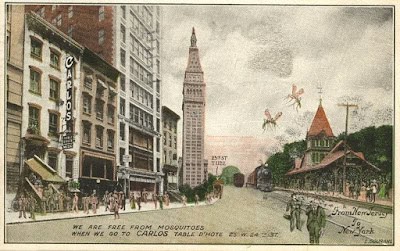
This postcard from about 1912 promotes an Italian restaurant named The Carlos to New Jerseyites by claiming it was “free from mosquitoes.” The confusing scene shows a New York cityscape on the left and a railroad platform in New Jersey on the right where swarms of mosquitoes can be seen harassing commuters standing on the platform.
In reality, The Carlos was located at 25 West 24th Street, near both Madison Square Park and the Hudson Tube Station shown in the distance on the card. More interestingly, it faced the drab façade of a building across the street that hid the love nest of architect Stanford White who rented the second and third floors for his trysts, fitting the rooms with mirrored walls, a canopy bed, and a red velvet swing.
Much of what we know about this restaurant and its bohemian spirit comes from postcards and from the diary of one of its most famous patrons.
P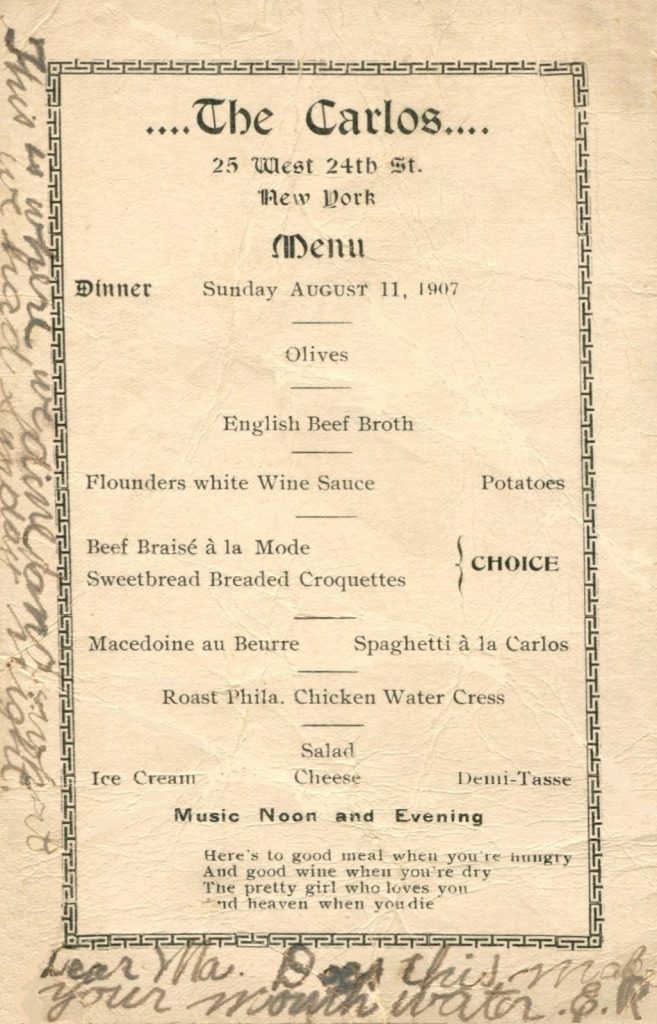 ostcards were then a new thing, providing an ideal way for a small restaurant featuring a foreign cuisine to advertise its fixed price menu; such places were known as “table d’hotes.” The postcard below shows the set menu for Sunday, August 11, 1907. Italian table d’hotes typically employed this basic format for their fixed price menus which usually included an eponymous pasta dish like the spaghetti a la Carlos offered here.
ostcards were then a new thing, providing an ideal way for a small restaurant featuring a foreign cuisine to advertise its fixed price menu; such places were known as “table d’hotes.” The postcard below shows the set menu for Sunday, August 11, 1907. Italian table d’hotes typically employed this basic format for their fixed price menus which usually included an eponymous pasta dish like the spaghetti a la Carlos offered here.
Although this card was never mailed, it has a personal note written in the border. It was not until October 1, 1907, that the Universal Postal Union allowed postal cards of member nations to have written messages on the address side.
After the ruling, printers placed a vertical line on the back, ushering in the so-called “Golden Age of Postcards” that lasted until about 1915. The main dining room of the Carlos is shown on the card below.
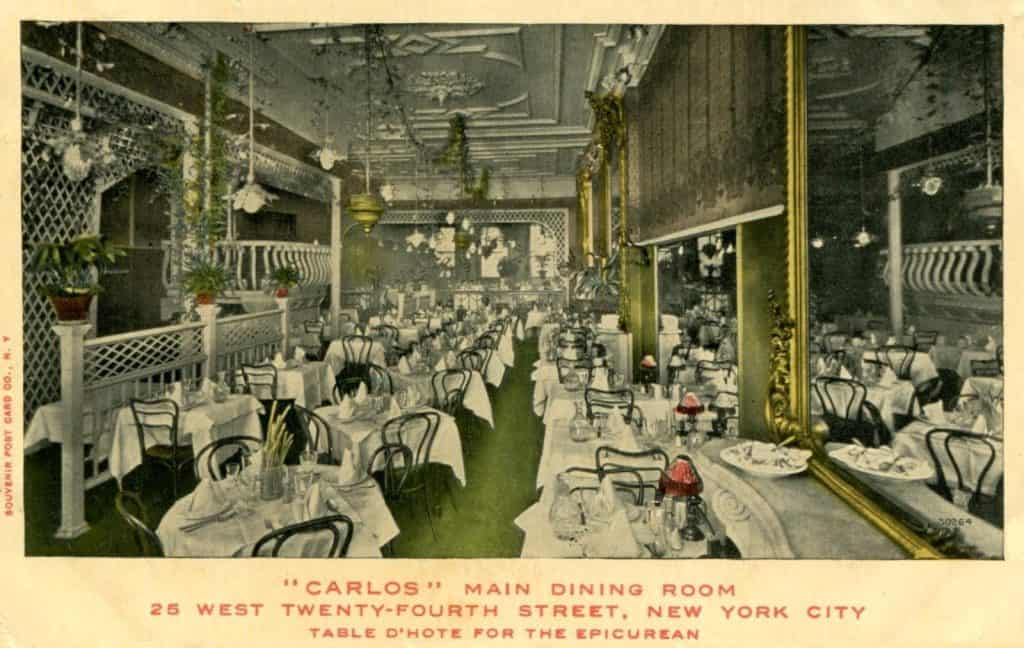
Artist John Sloan recorded several visits to the Carlos in his diary.
As a leading member of the Ashcan School of realist painters, he depicted various aspects of daily life, including scenes in bars and restaurants.
His painting titled “Renganeschi’s Saturday Night” shows a comparable eatery on West 10th Street in Greenwich Village. After working on the painting “Throbbing Fountain, Night,” Sloan took his wife Dolly to The Carlos on August 29, 1908, making its first appearance in this diary.
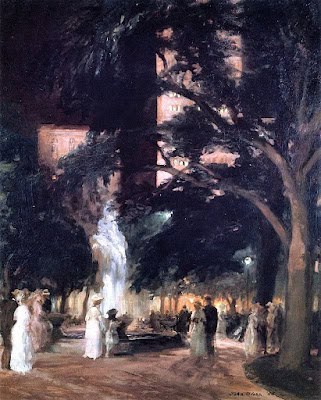
The couple returned to the “Carlos table d’hote” for dinner on September 16 of that year, partly to celebrate a commission he received from Scribner’s and partly because Dolly was tired, having put up twenty-two jars of peach jam that day. The restaurant was only a five-minute walk from their apartment at 165 West 23rd Street.
Sloan also went there with friends.
On January 2, 1909, after spending the afternoon drinking at a hotel bar, he and fellow painter Ernest Lawson went to the Carlos. Afterward, the two artists “toddled” over to Mouquin’s and later to an unnamed Chinese restaurant. Meanwhile, Dolly became so worried that she phoned artist Robert Henri in the middle of the night for help. Henri, in turn, called the police station. Sloan finally got home at 3:30 A.M. Later that year, after crossing over from New Jersey on a trip from Philadelphia, Sloan again met Lawson at the “Café Carlos.”
The postcard below comes from Sunday, August 8, 1909. On the weekends, the fixed price menu was seventy cents, a nickel more than the regular price. Once again, spaghetti à la Carlos appears as the pasta dish. In addition to its set themed dinner, an Italian d’hote served typical American food.
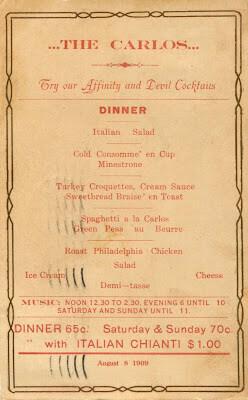
Carlos was a gathering spot for colleagues to meet for drinks. In addition to the customary one-dollar pint of Chianti wine, this menu card promotes two cocktails. The “Affinity” was made with one-third parts of French vermouth, Italian vermouth and Scotch whisky, finished with two dashes of bitters. The “Devil” may have comprised French vermouth with a tenth part bitters made from devil’s club root. Special cocktails then cost about fifteen cents.
Nine days later (August 17th), Sloan went to the Carlos to see several colleagues, including Ernest Lawson and cartoonist Rudolph Dirks, creator of “The Katzenjammer Kids.” Sloan recounted the evening in his diary:
“Later on, Arthur G. Dove came in. First I have seen of him since his return from Paris, he has been back for about three weeks. Walt Kuhn also joined the party and (Rudolph) Block who is the ‘art’ editor of the (New York) Journal comics. I had three Irish whiskeys and got careless enough to suggest…that we go to (eat) in Koster and Bials cellar – a rather shabby low resort where we had roast beef sandwiches and watched the women. A fat one with a lean old fish nibbling at the hook asked the piano player “Professor, can you play us the ‘Glow Worm?”
When you read the profiles of the personalities that frequented these establishments it makes you realise the impact immigration had on the development of American life and culture.
I have not seen the claim “we are free from mosquitoes” before…How interesting and amazing.
I believe the buttered green peas were served as an accompaniment to the spaghetti, not on top of the pasta. In the older card, there is a reference to Macedoine au Beurre, a mixture of vegetables with butter, alongside the spaghetti. Also, the 1909 dinner cost $1 with chianti and 65 or 70 cents without, suggesting the charge for the wine alone was about thirty cents.
This card is posted on behalf of Kyle Jolliffe who wants you to know that the image was created by the same artist who did the Mosquito card in Mr. Voigt’s article.